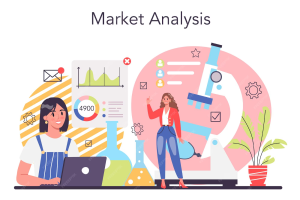Introduction — The Future of Internet Marketing Analytics in the AI Era

Internet Marketing Analyst roles are evolving rapidly in the AI era. As businesses increasingly rely on data-driven insights, these professionals are no longer just monitoring metrics—they are shaping digital strategies, leveraging artificial intelligence (AI), machine learning (ML), and automation to drive growth and optimize marketing performance. For insights into AI’s role in marketing, see HubSpot’s guide to AI in Marketing
As the digital ecosystem grows more complex, businesses are increasingly dependent on Internet Marketing Analysts to navigate a data-driven world. But in 2025 and beyond, the traditional analyst role is evolving rapidly — thanks to artificial intelligence (AI), machine learning (ML), and automation.
In earlier years, analysts primarily gathered data from tools like Google Analytics, measured campaign performance, and prepared reports for stakeholders. Now, with the integration of AI-powered analytics, they have transformed from data collectors into strategic decision-makers.
AI allows analysts to predict customer behavior, automate insights, and personalize marketing campaigns with unprecedented precision. However, this advancement also brings new challenges — requiring analysts to adapt, upskill, and embrace emerging technologies.
This article explores how AI is transforming the world of internet marketing analytics, what the future holds for analysts, and the skills and tools needed to stay ahead.
Impact of AI on Internet Marketing Analyst Jobs
Artificial Intelligence is not replacing Internet Marketing Analysts — it’s reshaping their responsibilities.
AI tools now handle many of the repetitive, manual tasks analysts once did. But this shift frees professionals to focus on strategic insights, predictive modeling, and campaign optimization.
1. From Manual to Intelligent Data Analysis
Before AI, analysts spent countless hours cleaning and merging data from multiple platforms. Today, AI-powered analytics platforms like Google Analytics 4, HubSpot AI, and Salesforce Einstein automate these tasks, providing clean, actionable insights in real time.
This enables analysts to focus on understanding why metrics change — not just what changed.
2. Predictive and Prescriptive Insights
AI enables predictive analysis by studying historical trends to forecast future outcomes. Internet Marketing Analysts can now:
- Predict customer churn rates.
- Identify which content will perform best.
- Forecast future sales and campaign ROI.
These insights help businesses make smarter, proactive decisions rather than reactive corrections.
3. Evolving Skill Sets
The modern Internet Marketing Analyst is part strategist, part technologist, and part data scientist. They must understand how to:
- Train and monitor AI tools.
- Interpret algorithmic predictions.
- Communicate technical data insights in simple, actionable language.
Knowledge of Python, R, SQL, and AI-driven platforms is becoming increasingly valuable, alongside marketing fundamentals.
4. New Job Titles Emerging
As AI integrates deeper into digital marketing, we’re seeing the rise of hybrid roles like:
- AI Marketing Strategist
- Digital Intelligence Analyst
- Marketing Data Engineer
- Automation & Insights Manager
These roles blend marketing expertise with advanced analytical and technological skills — defining the next generation of marketing professionals.
How Internet Marketing Analysts Use Automation Tools
Automation tools have revolutionized how analysts collect, analyze, and act on data. They allow for faster decision-making, improved accuracy, and seamless campaign optimization.
1. Automated Reporting and Dashboards
Tools like Looker Studio (formerly Google Data Studio), Supermetrics, and Databox automate multi-channel reporting. Instead of compiling spreadsheets manually, analysts can:
- Connect multiple platforms (Google Ads, Facebook, LinkedIn).
- Auto-generate live dashboards.
- Receive real-time alerts when metrics fluctuate.
This means less time on data entry — and more time on analysis.
2. Marketing Automation Platforms
Internet Marketing Analysts leverage tools such as HubSpot, Marketo, and ActiveCampaign to track lead behavior, score engagement, and personalize marketing efforts. AI algorithms segment audiences, send emails automatically, and recommend content dynamically.
3. AI-Powered SEO Tools
SEO analysis has become smarter thanks to tools like Semrush, Ahrefs, and Moz Pro, which use AI to:
- Identify keyword gaps.
- Analyze backlink profiles.
- Monitor competitor strategies.
- Suggest optimization opportunities.
AI helps analysts prioritize the most valuable SEO actions instead of manual trial-and-error.
4. PPC and Ad Optimization
Platforms such as Optmyzr, Revealbot, and Google Ads Smart Bidding use machine learning to optimize bidding strategies, targeting, and ad placements automatically.
Analysts now focus on interpreting results, testing creatives, and aligning ad performance with overall marketing goals.
- Predictive Analytics & Customer Journey Mapping
With AI-driven tools like Amplitude, Mixpanel, and Adobe Analytics, analysts can map customer journeys and predict behavior patterns. These platforms analyze how users interact with content, what influences conversion, and when to re-engage prospects.
Trends in Digital Marketing Analytics 2025
The future of marketing analytics is intelligent, personalized, and privacy-conscious. Here are the top trends shaping the field in 2025:
1. Predictive and Prescriptive Analytics Become Mainstream
AI now not only forecasts what might happen but also suggests what actions to take next. For example:
- Predictive analytics tools anticipate customer churn.
- Prescriptive analytics recommend targeted re-engagement campaigns.
Platforms like Google Cloud AI, IBM Watson, and HubSpot AI are leading this evolution.
2. Unified Data Ecosystems
Marketers can no longer afford siloed data. Tools like Segment, Snowflake, and BigQuery integrate analytics from multiple sources — social media, CRM, web traffic, and advertising — into one system.
This gives analysts a complete 360° view of customer behavior and improves attribution accuracy.
3. AI-Powered Personalization
AI now enables real-time personalization across websites, emails, and ads.
- Content adjusts dynamically based on user behavior.
- Product recommendations change instantly with browsing history.
- Chatbots like Drift and Intercom provide tailored support.
Such personalization increases engagement, retention, and conversion rates.
4. Data Privacy and Ethical Analytics
As third-party cookies phase out, marketers rely on first-party data and consent-based tracking. Analysts must now balance insight generation with strict compliance under GDPR, CCPA, and evolving privacy standards.
5. Voice, Visual, and Conversational Search
By 2025, voice and image searches are reshaping SEO. Analysts are optimizing content for:
- Voice search queries using natural language processing (NLP).
- Visual recognition on platforms like Pinterest and Google Lens.
- AI assistants like ChatGPT Search, Alexa, and Siri.
These technologies require marketers to rethink traditional keyword and content strategies.
Importance of Data-Driven Decision-Making in Internet Marketing

In the AI era, decisions made on assumptions are costly. Data-driven marketing is the only reliable path to measurable success.
1. Turning Insights into Action
Internet Marketing Analysts use analytics to identify high-performing campaigns, weak areas, and customer preferences. These insights help businesses optimize their marketing spend and improve ROI.
For example:
- Using GA4, analysts can track which landing pages convert best.
- Using HubSpot, they can attribute leads to specific campaigns.
This ensures every marketing dollar is strategically spent.
2. Customer-Centric Strategies
Data-driven marketing allows businesses to understand their audience deeply — not just by demographics, but by behavior, sentiment, and engagement. Analysts use this information to:
- Create hyper-targeted ads.
- Personalize website experiences.
- Develop products that align with customer needs.
3. Real-Time Decision Making
AI-powered tools deliver insights in real-time, enabling instant optimizations. For example, if a campaign underperforms, analysts can:
- Pause it automatically.
- Adjust creatives or audience targeting.
- Redeploy budgets toward higher-performing assets.
4. Strategic Business Alignment
Data-driven decision-making ensures marketing goals align with overall business objectives. It bridges the gap between marketing, sales, and operations — creating synergy across departments.
Analysts play a pivotal role by translating complex data into clear business strategies, helping leadership make informed decisions.
Common Mistakes to Avoid
Even in a tech-driven world, human errors can derail success. Internet Marketing Analysts should avoid the following pitfalls:
1. Overreliance on Automation
AI tools are powerful, but blind trust can be dangerous. Analysts must validate automated insights with human logic and contextual understanding.
2. Ignoring Data Quality
If the data input is flawed, the AI output will be unreliable. Regular audits, data cleaning, and consistency checks are essential for trustworthy analytics.
3. Focusing Solely on Vanity Metrics
High impressions or clicks may look impressive, but they don’t always translate into business growth. Analysts must prioritize metrics tied to conversions, ROI, and customer lifetime value (CLV).
4. Neglecting Privacy and Compliance
With tightening privacy laws, mishandling user data can lead to legal penalties and loss of trust. Always ensure transparency and obtain consent before collecting data.
5. Failure to Upskill
AI technology evolves quickly. Analysts who fail to learn new tools, languages, and analytical methods risk becoming obsolete. Continuous learning is essential.
6. Lack of Collaboration
Analytics doesn’t exist in isolation. The best insights come from collaboration between marketing, IT, design, and leadership teams. Ignoring cross-department input limits innovation and understanding.
Conclusion :
The Analyst’s Role in the Future of AI-Driven Marketing

The role of the Internet Marketing Analyst is evolving from operational to strategic — from reporting numbers to driving business growth through intelligent data insights.
In the AI era, successful analysts are those who combine:
- Technical mastery (AI, automation, predictive analytics)
- Creative problem-solving
- Ethical and data-driven judgment
As AI continues to redefine marketing, the demand for skilled analysts who can interpret, optimize, and humanize data will only grow stronger.
Key Takeaways:
- AI is transforming how analysts collect, analyze, and interpret data.
- Automation increases efficiency, but human insight remains critical.
- 2025’s trends focus on predictive analytics, privacy, and personalization.
- Data-driven decision-making empowers smarter marketing investments.
- Analysts who adapt, upskill, and embrace innovation will lead the future of digital strategy.
The future of Internet Marketing Analytics isn’t just about artificial intelligence, it’s about augmented intelligence: humans and machines working together to create marketing that’s smarter, faster, and more impactful than ever before.



